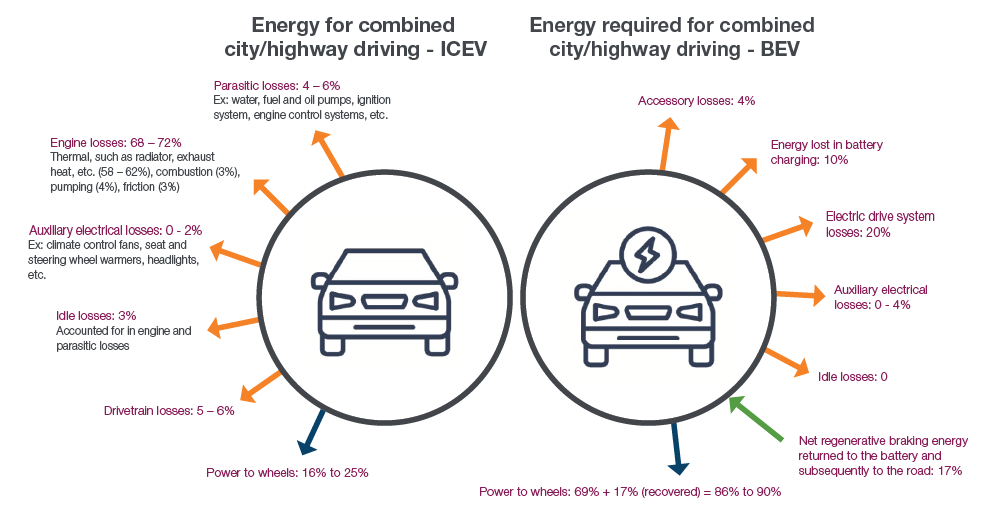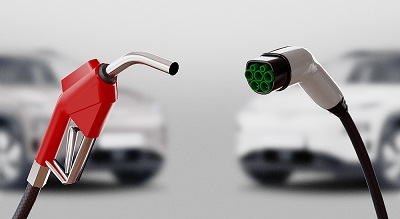Market Snapshot: Battery electric vehicles are far more fuel efficient than vehicles with internal combustion engines
Connect/Contact Us
Please send comments, questions, or suggestions for Market Snapshot topics to snapshots@cer-rec.gc.ca
Release date: 2021-02-24
Battery electric vehicles (BEVs)Footnote 1 for sale in Canada in 2021 are far more fuel efficientFootnote 2 than vehicles with internal combustion engines (ICEVs). This higher efficiency is largely because electric motors are much more efficient than internal combustion engines (ICEs).
In ICEVs, fuels like diesel and gasoline are ignited so the expanding gas pushes pistons to create motion. However, only 12% to 30% of the energy in gasoline is used to move a vehicle, with most of the remaining energy lost as heat.
BEVs, on the other hand, have electric motors, which use almost all of the energy in electricity to move the vehicle. BEVs also use “regenerative braking”, where, to slow down, the vehicle’s brakes convert kinetic energy (or motion) into electricity and store it in BEV batteries. Altogether, BEVs are far more efficient than ICEVs, with over 77% of the energy in electricity converted into movement when including regenerative braking.
Hybrid-electric vehicles (HEVs) are powered by both an electric motor and an internal combustion engine.Footnote 3 As a result, they are generally more efficient that ICEVs but less efficient than most BEVs.
Figure 1. Comparing where energy goes for combined city/highway driving in BEVs and ICEVs

Note: Some percentages may not add to 100% due to rounding.
Source and Description
Source: U.S. Department of Energy – Office of Energy Efficiency and Renewable Energy – Where the Energy Goes: Electric Cars, Gasoline Vehicles
Description: This infographic compares the energy losses of both ICEVs and BEVs for combined city/highway driving. Engine losses are the biggest for ICEVs at 68-72%. Energy losses for BEV are mostly from battery charging (10%) and electric drive system (20%). BEVs also have regenerative braking which can recover up to 17% of energy to recharge the battery.
Figure 2 shows the fuel economies of BEVs, ICEVs, and HEVs for sale in Canada in 2021 in litres equivalent per 100 km (Le/100km) driven.Footnote 4 Fuel-economy testing for these vehicles consists of five stages, including some cold weather conditions (with temperatures down to -7 °C). While ICEV fuel economy can fall 15% at temperatures of about -7 °C, it can fall 30% for HEVs and 39% for BEVs, and can fall even more for BEVs when temperatures are even lower. BEV fuel economy falls more in the cold than ICEV fuel economy, largely because BEVs use extra electricity to heat the BEV’s battery and passenger cabin while ICEVs can use heat that is normally wasted. Still, even if a BEV’s fuel economy falls by 50%, it would still have better fuel economy than comparable ICEVs.
Figure 2. Fuel economies of battery-electric, hybrid-electric, and internal combustion engine vehicles for sale in Canada in 2021
Source and Description
Source: Natural Resources Canada 2021 Fuel consumption ratings
Description: This chart shows fuel economies for tested battery-electric, hybrid-electric, and internal combustion engine vehicles available for sale in Canada in 2021 and by vehicle class. According to the chart, battery-electric vehicles consume less energy (in litres equivalent) per 100 km driven than hybrid-electric vehicles, and much less energy than internal-combustion engine vehicles.
While more fuel efficient, BEVs currently cost more to buy than comparable ICEVs. This makes it more complicated to determine if a BEV’s lower fuel costs saves an owner money versus buying an ICEV. It is also worth noting that Canada’s personal vehicle fleet is typically heavier and larger than in other countries. This means the average personal vehicle owned by Canadians ranks amongst the worst in the world in fuel economy.
How do you compare fuel economies between battery-electric vehicles, hybrid-electric vehicles, and internal combustion engine vehicles?

- ICEVs consume gasoline or diesel or other liquid fuels measured at Canadian fuel pumps in litres (L), while BEVs consume electricity, which is measured in kilowatt hours (kW.h). HEVs consume gasoline, though convert some of that energy into electricity.
- Both gasoline and electricity contain energy. One kW.h contains 3.6 megajoules (MJ) of energy while 1 L of gasoline contains 32.0 MJ of energy. Thus, 1 L of gasoline contains the equivalent of 8.9 kW.h of energy, and the amount of electricity consumed by a BEV per 100 km driven can be converted to litres equivalent (Le) of gasoline consumed.
- Date modified:
